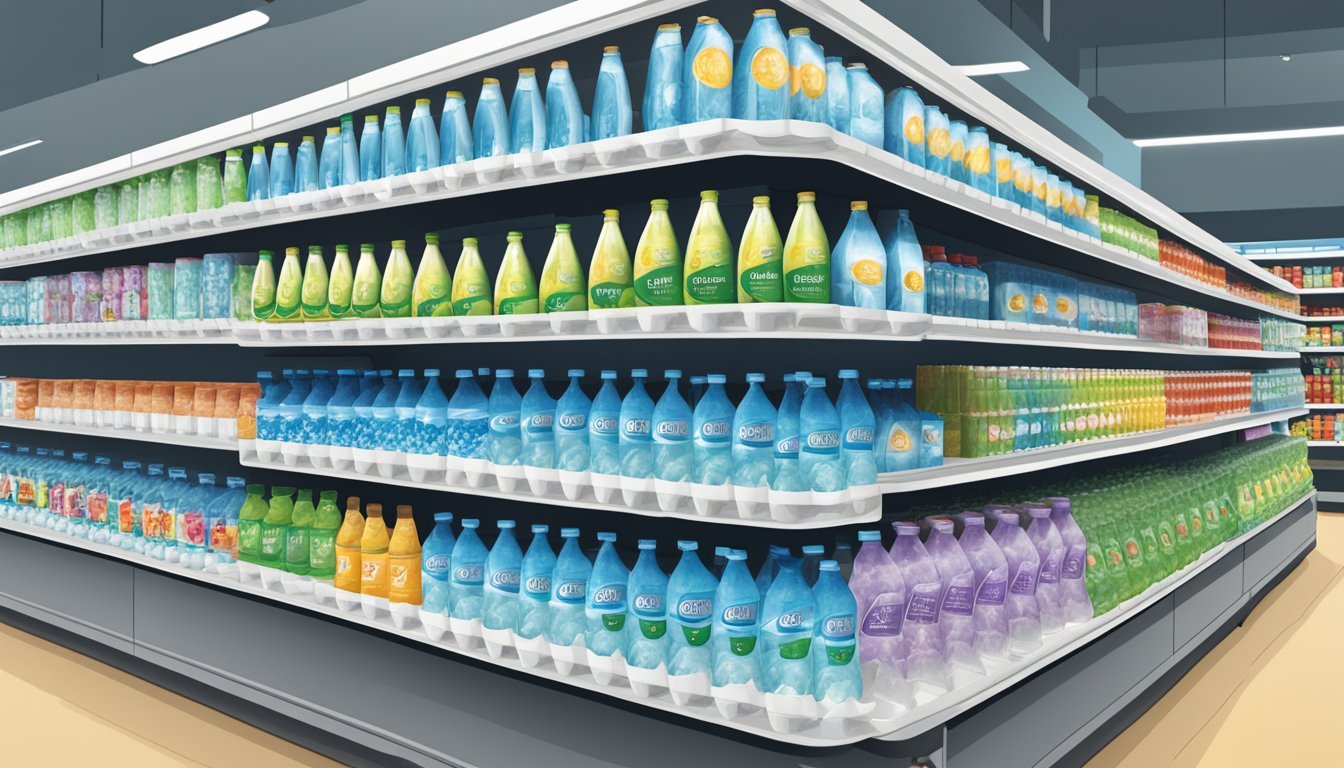Penta vs. Path
Comparing Quality and Taste of Bottled Water
Penta and Path are both prominent names in the premium bottled water market, each promising unique benefits that cater to health-conscious consumers. Penta water touts its ultra-purified qualities and slightly alkaline pH, which aims to offer a crisp and clean taste. In contrast, Path markets itself on sustainability with its reusable aluminum bottles, making it an eco-friendly option for those looking to reduce single-use plastic.
The choice between Penta and Path ultimately boils down to individual preferences and priorities. For those seeking ultra-purified water with a balanced pH, Penta might be the better option. On the other hand, consumers who prioritize environmental sustainability might find Path's reusable aluminum bottles more appealing.
Exploring the unique selling points of each brand can help consumers make an informed decision. Diving into the specifics of Penta’s purification process and Path’s sustainability efforts reveals what sets these two brands apart. Whether you're a health enthusiast or an eco-conscious shopper, this comparison aims to guide you toward the best choice.
The Rise of Bottled Water in the Market
The bottled water industry has experienced significant growth, driven by changing consumer preferences and increasing concerns over tap water quality. Global sales have surged, making the market a key segment within the beverage industry.
Understanding Consumer Preferences
Consumers are increasingly health-conscious and prefer bottled water for its perceived purity and convenience. Many areas lack access to clean tap water, driving demand for bottled alternatives. Brands like Fiji, Evian, and Smartwater are popular due to their pristine sources and marketing strategies that emphasize health benefits. The desire for convenience also plays a crucial role, with bottled water readily available at grocery stores and vending machines.
Comparison of Bottled Water Brands
Different brands cater to various consumer needs. Dasani and Aquafina are widely accessible and budget-friendly, while premium brands like Voss and Penta offer unique selling points such as enhanced purity and mineral content. Path has positioned itself as a sustainable option with recyclable packaging. Nestlé Pure Life and Poland Spring dominate with large market shares. Specialty waters like Icelandic Glacial and Mountain Valley Spring Water target niche markets focused on specific mineral compositions and natural sources.
Market Trends and Bottled Water Consumption
The market for bottled water has grown rapidly, with North America, Europe, and Asia showing the highest consumption rates. Consumers increasingly seek products that align with health and wellness trends. There is also a rising demand for eco-friendly options as environmental concerns gain traction. The introduction of functional waters—infused with vitamins and minerals—reflects this trend. According to recent data, the U.S. bottled water market alone represents 13.7% of the global market, highlighting its significant contribution to the industry's overall growth.
Health Considerations in Bottled Water
When comparing bottled water options like Penta and Path, it's essential to understand factors like electrolytes, pH balance, and mineral content, which directly impact health benefits and hydration.
Electrolytes and Hydration
Electrolytes are minerals like sodium, potassium, and magnesium, found in many bottled waters, crucial for maintaining hydration and muscle function. Athletes particularly benefit from electrolyte-rich water during intense physical activities as it aids in replacing lost minerals.
Penta water focuses on ultra-purity and does not add electrolytes. In contrast, some other brands, such as Essentia Ionized Water, include added electrolytes for enhanced hydration. This difference can influence user preference based on hydration needs, especially in active lifestyles.
The Significance of pH Balance
The pH level of water can affect acidity and alkalinity in the body. Alkaline water, with a pH above 7, is said to neutralize acid in the bloodstream, potentially offering various health benefits. Path waters often feature balanced pH levels to cater to health-conscious consumers.
Penta water maintains a neutral pH, aligning closely with the natural body's pH level, which is around 7. This neutrality can help harmonize within the body without altering its delicate balance.
Assessing Mineral Content and Water Purity
Mineral content and purity are crucial for overall health. Natural spring water often contains beneficial minerals like calcium and magnesium. Mineral water sources these elements naturally, supporting bone health and cardiovascular function.
Penta water is known for its extensive purification process, removing impurities but also reducing the mineral content. Purified water is attractive to those prioritizing purity, while some consumers prefer mineral-rich options for added health benefits.
Understanding these elements can guide informed choices between different bottled water brands based on specific health needs and preferences.
Bottled Water Quality and Purification Processes
When evaluating bottled water quality, the purification processes employed by different brands play a crucial role. Key aspects include the variety of filtration methods used, the importance of avoiding contamination, and adherence to stringent standards of purity and safety.
Reverse Osmosis and Other Filtration Methods
Reverse osmosis is a common and effective filtration method used by many bottled water brands, including Penta, which results in ultra-purified water. This process involves forcing water through a semipermeable membrane to remove contaminants, heavy metals, and other impurities.
In addition, some brands use deionization, which exchanges ions in the water to remove mineral salts. Ozonation is another method employed, involving the infusion of ozone gas to disinfect the water. Each of these methods contributes to the overall purity and taste of the water.
Importance of Avoiding Contamination
Avoiding contamination throughout the bottling process is essential. Contaminants like heavy metals, bacteria, and other harmful substances can compromise water safety and quality. Steps must be taken throughout sourcing, purification, and bottling to ensure water remains uncontaminated.
Plastic bottles, especially those containing BPA, can also pose a risk of leaching chemicals into the water. Choosing BPA-free bottles helps in maintaining water purity. Effective purification methods, along with diligent quality control, minimize the risk of contamination.
Standards of Purity and Safety
Stringent standards govern bottled water quality and safety. Regulatory bodies like the FDA in the United States set guidelines that bottled water must meet to be deemed safe for consumption. These standards cover permissible levels of contaminants, such as heavy metals and microbial content.
Brands like Penta often seek third-party certifications to validate their water’s purity. These certifications can provide assurance that the water meets high safety and quality benchmarks. Adhering to these standards is vital for consumer trust and health.
In essence, the quality and purification of bottled water demand rigorous processes and adherence to high safety standards. Brands that implement advanced filtration methods and maintain strict contamination controls typically offer superior water quality.
Environmental Concerns and Innovation
When comparing Penta and Path bottled water, it is crucial to address environmental concerns and the innovations each brand brings to the table. This section will focus on plastic use, BPA exposure, and advancements in eco-friendly packaging.
Plastic Use and BPA Exposure
Penta uses plastic bottles made from BPA-free material, which is important for consumer safety. Bisphenol A (BPA) is a chemical found in some plastics linked to health problems, making its absence in Penta bottles a selling point.
Path, on the other hand, offers bottles primarily made from aluminum, known for being more recyclable than plastic. This reduces environmental impact, as aluminum can be recycled indefinitely.
While both companies make strides in reducing harmful chemicals, Path's choice of aluminum over plastic presents a stronger case for those prioritizing environmental sustainability.
Innovations in Eco-Friendly Packaging
Penta focuses on the purity of its water, utilizing high-grade filtration systems. These systems aim to provide clean drinking water with less environmental impact through more efficient processes.
Path is innovative with its refillable aluminum bottles, encouraging consumers to reuse containers rather than disposing of single-use bottles. This practice can significantly lower the environmental footprint associated with bottled water consumption.
Additionally, Path's partnership with suppliers to ensure sustainable practices in sourcing and packaging underscores its commitment to environmental stewardship. This makes Path a standout choice for eco-conscious consumers.
By leveraging recyclable materials and encouraging reusable packaging, both brands contribute meaningfully to reducing the environmental impact of bottled water.
Taste Profiles and Water Sommelier Insights
When comparing Penta and Path bottled waters, taste profiles and insights from water sommeliers offer essential perspectives. Examining their distinct characteristics helps in understanding preferences and choices.
Analyzing Bottled Water Taste Variations
Penta and Path have unique taste profiles influenced by their mineral compositions. Penta is often noted for its ultra-purified process, which results in a clean, almost neutral taste. This makes it a preferred choice for those who like their water to be as pure and unaltered as possible. Consumers frequently describe its taste as crisp and refreshing.
Path, on the other hand, sources its water from natural springs and prides itself on minimal processing. This results in a more robust flavor profile. Some liken it to the experience of drinking directly from a mountain stream. The presence of natural minerals gives Path a subtle, yet distinctive taste that some describe as slightly earthy or metallic, depending on the source.
The Professional Opinion of Water Sommeliers
Water sommeliers provide expert insights into the nuanced differences between bottled water brands like Penta and Path. Martin Riese, a renowned water sommelier, emphasizes the importance of source and purification processes in determining taste.
For Penta, the process of extensive purification results in a clean palette that sommeliers might describe as a "blank canvas." It's often recommended for those who appreciate neutrality in their water's taste profile.
Path’s natural spring origins offer a contrasting experience. Sommeliers highlight the complexity and character in its flavor, appreciating the natural mineral content. This complexity can bring the consumer closer to nature. Such insights assist in understanding why one might prefer one brand over the other based on personal taste preferences.
Bottled Water vs. Tap and Spring Water
Bottled water, tap water, and natural spring water each have their unique attributes and benefits. This section will explore the main differences, advantages, and drawbacks between these three types of water.
Comparing Bottled Water to Tap Water
Bottled Water boasts convenience and availability in various stores, making it a go-to choice for many on the go. Despite this, bottled water is significantly more expensive than tap water. Additionally, the environmental impact is substantial due to the plastic waste generated from single-use bottles.
Tap Water is sourced from municipal supplies, including wells, lakes, and reservoirs. It is highly regulated by local governments to ensure safety standards. Tap water is economical, costing much less than bottled water. Environmentally, it is a more sustainable choice as it avoids the plastic waste issue and encourages the use of reusable containers.
The Allure of Natural Spring Waters
Natural Spring Water is derived from underground aquifers and surfaces naturally. It is often labeled as pre-purified because it travels through natural filters before reaching the surface. Many consumers perceive spring water as purer and more refreshing due to its natural filtration process.
Spring Water is another form of bottled water but is distinct from other bottled options as it must come from a natural spring. This type of water often contains beneficial minerals that can enhance taste and possibly offer slight health benefits. However, it still shares the high cost and environmental impacts associated with bottled water.
Cost Analysis of Premium Water Brands
When examining premium bottled water, factors like price and brand value are crucial. This section covers the costs associated with Penta and Path, offering an analysis of how their pricing reflects their purported purity and value propositions.
Evaluating the Price of Purity
Penta positions itself as a high-end water brand, often priced higher than many competitors. The justification for this premium price is rooted in its rigorous purification process, which includes a patented 13-step process to ensure exceptional purity. Consumers who prioritize water purity and are willing to pay more may find Penta appealing.
Path, on the other hand, markets itself as a sustainable premium water brand with refillable aluminum packaging. While the initial cost for a bottle of Path can also be high, it is designed for reuse, which could provide long-term savings for eco-conscious consumers. Evaluating these two brands requires considering both the upfront cost and potential cost savings from reusability in Path's case.
Brand Approximate Initial Cost Features Penta $2.50-$3.50 per bottle 13-step purification Path $2.00-$3.00 per bottle Reusable, eco-friendly packaging
Premium Brands and Their Value Proposition
When comparing Penta and Path, it is essential to consider their value propositions. Penta's higher cost is largely attributed to its intensive purification techniques, appealing to those who place significant value on water quality and purity. This brand targets consumers looking for what they perceive to be the purest water available.
Path offers a different value proposition by emphasizing sustainability and convenience through reusable aluminum bottles. While the initial cost for Path is comparable to other premium water bottles, the potential for reuse aligns with consumer trends towards sustainability and environmental consciousness. This can be a significant factor for buyers invested in reducing waste and supporting eco-friendly practices.
In conclusion, both brands offer unique value propositions. Penta focuses on purity with its advanced filtration process, justifying its higher price. Path, with its reusable packaging, provides an eco-friendly option that could save money over time.
Conclusion
Penta and Path offer distinct qualities that may appeal to different preferences and needs. Penta water is known for its thorough purification process, boasting ultra-purity and no additives. This may attract those who prioritize the cleanest possible hydration.
Path, on the other hand, emphasizes sustainability with its reusable aluminum bottles. It caters to environmentally conscious consumers looking to reduce plastic waste.
When evaluating hydration, Penta's micro-filtration ensures pure water, but Path may offer a slight edge with the added convenience of reusable packaging that can aid on-the-go lifestyles.
Flavor also plays a role. Penta is often described as smooth and flavorless, appealing to those who prefer neutral-tasting water. Path water has a slightly crisper taste due to its packaging but remains generally neutral.
Choosing between Penta and Path ultimately depends on individual priorities:
If purity and taste without extras are key, Penta may be the better option.
For those placing sustainability and reusability at the forefront, Path is an appealing choice.
In comparing these two, it is clear that both have their unique strengths. Each caters to different aspects of what one might seek in the best bottled water.
More About Penta
Mountain Valley Spring Water vs Penta: Which Bottled Water is Better?
Penta vs Richard's Rainwater: Which Bottled Water is Better?
Penta vs Whole Foods Italian Still Mineral water: Which Bottled Water is Better?








